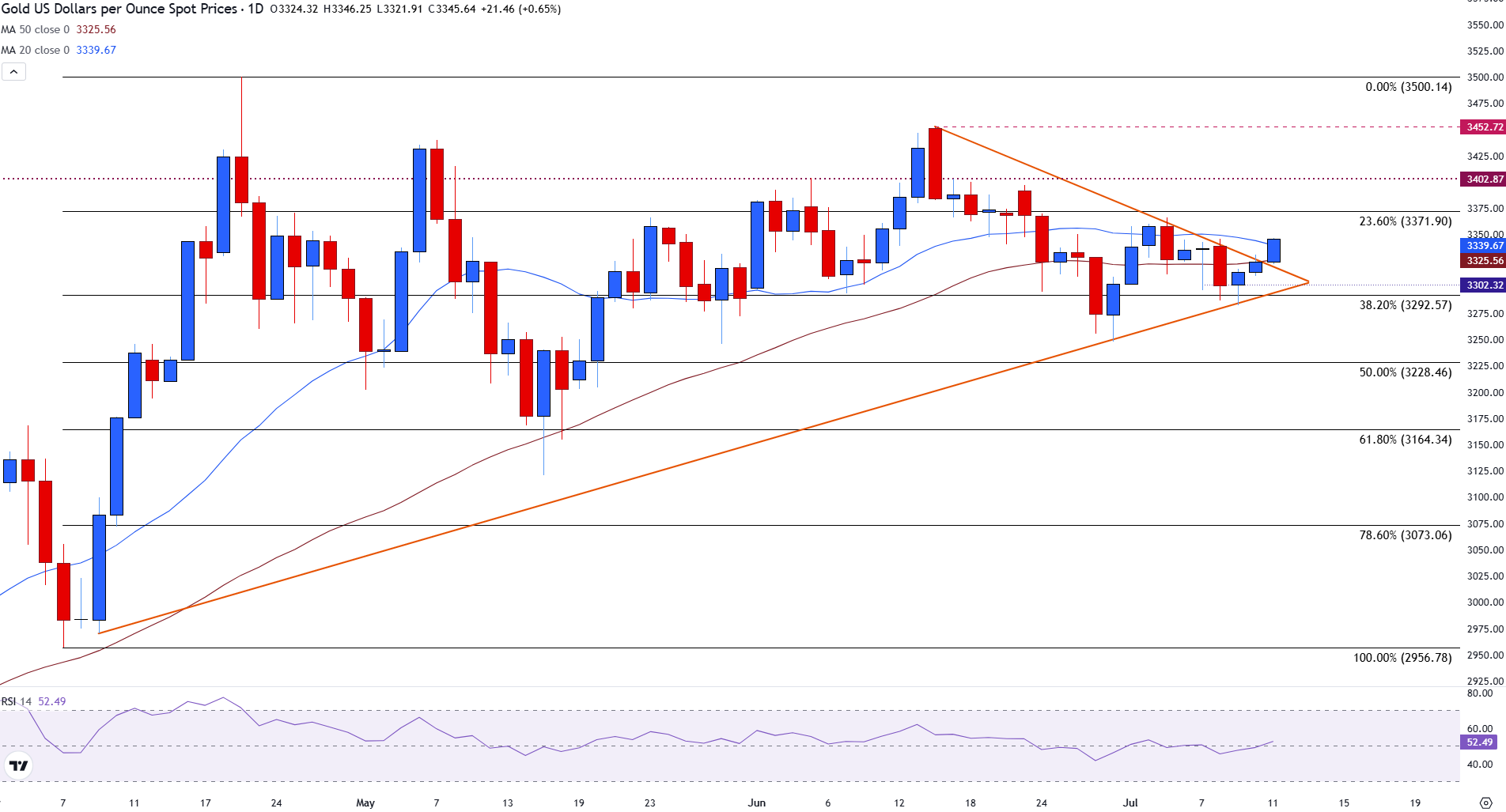Gold spikes as safe-haven demand surges on Trump's tariff threats
- Gold gains as its safe-haven appeal benefits from fresh tariff threats.
- President Trump threatens 35% tariffs on Canadian imports to the US.
- XAU/USD flirts with the 20-day moving average after breaking above triangle resistance.
Gold (XAU/USD) price surged on Friday, trading above $3,340 at the time of writing, as trade tensions and safe-haven demand have overshadowed rising US yields.
US President Donald Trump announced on Friday a sweeping 35% tariff on all Canadian imports, effective from August 1, in a move that rattled global markets.
The decision is particularly significant given that the United States is Canada’s largest trading partner, accounting for 76% of Canadian exports in 2024, according to Statistics Canada.
Trump also warned of broader action, stating: “We’re just going to say all of the remaining countries are going to pay, whether it’s 20% or 15%. We’ll work that out now.”
His remarks fueled fears of a new wave of blanket tariffs, boosting demand for Gold as a tariff risk hedge.
Gold daily digest: XAU/USD benefits from safe-haven demand on broader tariff risks
- The release of the Federal Reserve’s (Fed) June meeting Minutes on Wednesday revealed growing concern among policymakers about the inflationary impact of escalating tariffs. The minutes noted that “most participants highlighted the risk that tariffs could have more persistent effects on inflation.” Officials also reiterated they are “well-positioned to wait for more clarity on the outlook for inflation and economic activity.”
- According to the CME FedWatch Tool, markets now see a 62.9% probability of a 25 basis point interest rate cut in September. So far this year, the Fed has kept interest rates unchanged within the 4.25%–4.50% range.
- Meanwhile, President Donald Trump escalated trade tensions this week by announcing a 50% tariff on Copper, effective August 1, citing national security concerns. “I am announcing a 50% TARIFF on Copper, effective August 1, 2025, after receiving a robust NATIONAL SECURITY ASSESSMENT. America will, once again, build a DOMINANT Copper Industry,” Trump declared on Truth Social on Wednesday.
- Brazil was also hit with a 50% tariff, with Trump directly linking the move to what he called the political persecution of former President Jair Bolsonaro, describing the proceedings as a “witch hunt”. He further ordered a Section 301 investigation into Brazil’s digital trade practices, signaling the potential for additional tariffs.
- At a Cabinet Meeting on Tuesday, Trump confirmed that the August 1 tariff deadline would not be extended, stating that “Everybody has to pay. And the incentive is that they have the right to deal in the United States.” Reinforcing this stance, he later wrote: “TARIFFS WILL START BEING PAID ON AUGUST 1, 2025. There has been no change to this date, and there will be no change.”
- For Gold, these developments may continue to support the metal’s safe-haven appeal.
Gold technical analysis: XAU/USD breaks triangle resistance, heads toward $3,400

Gold daily chart
Gold has pushed through a symmetrical triangle resistance, allowing XAU/USD to test the 20-day Simple Moving Average (SMA) at $3,340.
The Relative Strength Index (RSI) rises, pointing upwards near 53 on the daily chart, signalling a slight bullish momentum in Gold.
But upside risks remain firm. The 23.6% Fibonacci retracement of the April uptrend stands at around $3,372, which could limit additional gains. Further up, the $3,400 psychological level and the June high near $3,452 are the next targets.
Meanwhile, if the US Dollar (USD) manages to gain traction and risk sentiment improves, then the 50-day SMA could come into focus at $3,325 as support. Below that level, focus turns to the $3,300 psychological level and the 38.2% Fibonacci retracement at $3,292.
Gold FAQs
Gold has played a key role in human’s history as it has been widely used as a store of value and medium of exchange. Currently, apart from its shine and usage for jewelry, the precious metal is widely seen as a safe-haven asset, meaning that it is considered a good investment during turbulent times. Gold is also widely seen as a hedge against inflation and against depreciating currencies as it doesn’t rely on any specific issuer or government.
Central banks are the biggest Gold holders. In their aim to support their currencies in turbulent times, central banks tend to diversify their reserves and buy Gold to improve the perceived strength of the economy and the currency. High Gold reserves can be a source of trust for a country’s solvency. Central banks added 1,136 tonnes of Gold worth around $70 billion to their reserves in 2022, according to data from the World Gold Council. This is the highest yearly purchase since records began. Central banks from emerging economies such as China, India and Turkey are quickly increasing their Gold reserves.
Gold has an inverse correlation with the US Dollar and US Treasuries, which are both major reserve and safe-haven assets. When the Dollar depreciates, Gold tends to rise, enabling investors and central banks to diversify their assets in turbulent times. Gold is also inversely correlated with risk assets. A rally in the stock market tends to weaken Gold price, while sell-offs in riskier markets tend to favor the precious metal.
The price can move due to a wide range of factors. Geopolitical instability or fears of a deep recession can quickly make Gold price escalate due to its safe-haven status. As a yield-less asset, Gold tends to rise with lower interest rates, while higher cost of money usually weighs down on the yellow metal. Still, most moves depend on how the US Dollar (USD) behaves as the asset is priced in dollars (XAU/USD). A strong Dollar tends to keep the price of Gold controlled, whereas a weaker Dollar is likely to push Gold prices up.

